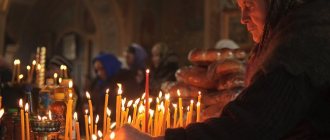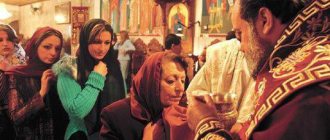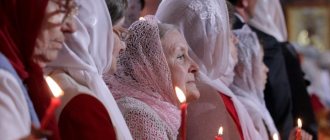"Save me, God!".
Thank you for visiting our website, before you start studying the information, please subscribe to our Orthodox community on Instagram, Lord, Save and Preserve † - https://www.instagram.com/spasi.gospodi/. The community has more than 60,000 subscribers. There are many of us like-minded people and we are growing quickly, we post prayers, sayings of saints, prayer requests, and timely post useful information about holidays and Orthodox events... Subscribe. Guardian Angel to you!
Many Orthodox believers are interested in the question of whether a woman can wear trousers to church. In fairness, it should be noted that often it is the style of clothing that becomes the reluctance to visit the temple. They often try to find answers to the above question in quotes from the Bible. At the same time, many people see them as a clear ban on women wearing trousers. But some people interpret it completely differently.
What does the Bible say about this
If you study the Old Testament well, then of course you can find the answer to the question of whether a woman can wear trousers to church. The Holy Book says that a woman should not be dressed in men's clothing, and a man in women's clothing. But, before drawing any conclusions, you first need to study in detail what kind of clothing was in those days.
Many people will probably be surprised, but in the Middle Ages, trousers as such did not exist in principle. They appeared in the wardrobe only in the 19th century. Also in Orthodox scripture it is said that by clothing for the opposite sex we mean comic clothing. It is intended for mummers.
Even in the Christian canons it is stated that a girl or woman should put on men’s clothing in order to perform asceticism. These words mean the deviation of a woman from the essence in which God created her. To summarize, we can say that the quotes and the Bible nowhere say that women are strictly prohibited from wearing trousers to church.
The best article for you, go to: Why is it buried in a closed coffin?
Why can't a woman wear trousers?
Arguing about trousers, headscarves, lipstick, hairstyles and other meaningless things can most harm a person who came to Church not to look like a believer, but to be one.
Ask this question to the Orthodox and you will receive a quick and clear answer: It’s not allowed, that’s the tradition. Those more experienced in Scripture may add: the Apostle Paul said that a woman should not wear men’s clothing.
In fact, this prohibition is found in the Old Testament. “A woman must not wear men’s clothing, and a man must not put on a woman’s clothing, for whoever does these things is an abomination to the Lord your God” (Deut. 22:5). And the Apostle Paul, if he has something similar in mind, is not talking about clothing, but about hairstyle and headdress (1 Cor. 11:4-15).
What men's clothing should a woman not wear? If we ask what men's and women's clothing looked like in those days, we will be surprised. We are not only not talking about trousers, they did not exist either in the times of the Old Testament, or in the times of the New, or even in the Middle Ages. Trousers as men's clothing appeared only in the 19th century. And in women's and men's clothing of ancient times, we will not see much difference: an undershirt to the knees and an outer cloak, this was the clothing of both men and women. About the differences, the Brockhaus Bible Dictionary says: “Women’s clothing was similar to men’s, but still had some differences. Women's robes were longer and wider than men's, and were probably made of thinner fabrics. “As you can see, the difference is not fundamental. This makes us think that we are talking not so much about the external, but about the internal difference between men and women, which, according to the commandment, should not be forgotten by either one or the other.
Perhaps the basis for the rejection of trousers can be found in the canons of the Orthodox Church? Rule 62 of the Sixth Ecumenical Council actually says: “. We define: no husband should dress in women’s clothing, nor a wife in clothes that belong to a husband. ", and then the continuation: ". nor wear comic disguises. when pressing grapes in winepresses, do not proclaim the vile name of Dionysus. ", etc., etc. It turns out that we are talking about the so-called mummers, and not about ordinary clothes. This entire rule is dedicated to various pagan customs penetrating into the Christian environment. There is another canonical rule, this time closer to our topic. Rule 13 of the Gangra Local Council reads: “If a certain wife, for the sake of imaginary asceticism, changes her attire, and instead of ordinary women’s clothing, puts on a man’s clothing, let her be under an oath.” This rule, as we see, denounces not clothing but imaginary asceticism, carried away by which, a woman ceases to be the way God created her.
A typical Pharisaic trait is the literal understanding of words spoken in a spiritual sense. Thus, at one time, the commandment: “Do not boil a kid in its mother’s milk” (Ex. 23:19), in the Pharisaic interpretation, turned into a gastronomic commandment about not eating milk and meat at the same time. But, even if we take the ban on men’s clothing for women literally, what does this have to do with women’s trousers? After all, they are designed, tailored and sewn specifically for women. What kind of men's clothing is this that no man would wear under pain of torture? Trousers have been appearing on women since the beginning of the 20th century, and in the sixties, thanks to Yves Saint Laurent, they finally became women's clothing. Now the definition of men's clothing simply does not apply to them.
Thus, we clearly see that nothing is said about trousers as a model of clothing in either the Old or New Testaments. The canonical rules of the Orthodox Church say nothing about trousers, and clothing in general. Finally, the world itself perceives women's trousers as women's clothing. Moreover, in the Church there were cases when women wore really men's clothes, the real ones. For example, St. blzh. Xenia of Petersburg, or Elder Dositheus of the Kyiv Chinese Hermitage, who turned out, as they say, to be a woman in disguise, seeking a monastic feat and thus hiding from her relatives. Did the Church condemn them? Indeed, in both cases, one can recall the rule of the Gangra Local Council, which we mentioned. But the Church, instead of condemning, on the contrary, recognized them as saints, because it never accepted either the Old Testament or the canonical rules about clothing in the external sense, as a requirement of fashion and style, but gave it a spiritual meaning.
The opinion of the priests
Despite the fact that there is no strict ban anywhere, many priests adhere to the strict ban on women wearing trousers. They explain why they cannot wear trousers to church by the fact that clothing to some extent dictates certain forms of behavior that may be incompatible with Christian norms.
For example, in a skirt it is not convenient to sit in an untied position, but in trousers it is comfortable. According to the priests, such a change in manner can entail a change not only in behavior, but even in character.
Of course, today there is no strict ban on trousers. But still, if you have the option of wearing other clothes, then it is better to give preference to it. Of course, if you go to church in trousers, no one will kick you out. But be aware that in some churches this may still provoke a conflict.
It should also be noted that this prohibition is taken more seriously in monasteries. You should not visit the monastery in this form of clothing, even as a sightseer.
The opinion of the clergy
There is no consensus among the priests about the appearance of the girl in the temple. Many of them believe that if a woman in trousers wants to go into a temple to pray and light a candle, then nothing can stop her. No one can say for sure, but most of them tend to observe a strict ban on women's trousers.
This is especially true for monasteries where traditions are sacredly respected. Church ministers explain this rule by saying that clothing can influence behavior. For example, women in trousers often behave imposingly, choosing relaxed poses and movements, which brings with them the appearance of new character traits that are inappropriate for a Christian parishioner. In addition, the unusual appearance of a girl in the temple can incline other parishioners to the sin of condemnation.
Another part of the clergy says that a woman should not be prohibited from attending church just because she is wearing a piece of men's clothing. Such rules can drive many souls away from God.
Advice! There is currently no strict ban on women's trousers in church. Compliance with this rule may depend on the attitude of the priest and parishioners towards it.
In any case, it is better to respect the traditions and unwritten rules of the church, and, if possible, dress correctly for worship, but no one has the right to judge a woman who comes to church in trousers.
What clothes to wear to church
The main requirement for the clothes in which you will visit the temple is modesty and not flashy. Under no circumstances should you wear shorts and a T-shirt. The shoulders of a girl or woman must be covered. There are several recommendations on what clothes a woman should wear to church:
- A woman must wear a headscarf to church. If you saw a temple along the way and decided to go into it, but you didn’t have a scarf with you, then you can cover your head with a robe or hood. Even a hat or beret will do.
- Try not to wear pants. Better give preference to a skirt or dress . The length of the skirt for church should not be above the knee.
- If you are wearing a dress, then you need to choose a model with a closed collar and long sleeves. A model with three-quarter sleeves is also suitable. In any case, the chest and shoulders must be covered.
- You cannot attend church wearing high heels. Preference should be given to shoes with low heels or flat soles. These should be the most closed shoes possible.
The best article for you, go to: Christian holiday Epiphany
It is very important not to forget what kind of skirt should be worn in church. If you don’t have a knee-length skirt, you can even wear a floor-length model. In a short skirt, you may not be allowed into the church, and if they are, it will cause a lot of rage among the parishioners. Why provoke a conflict? After all, that’s not what people go to church for. At the same time, do not ignore the color of your clothes. Give preference to pastel and discreet colors. The main rule for choosing clothes is not to attract attention to yourself.
Tradition
The tradition of the Russian Orthodox Church is based on the fact that any believer must look modest, not attract the gaze of parishioners, not disturb someone else’s prayer and not arouse lust. Therefore, it is better to go to church in women’s clothing below the knees, with a scarf or stole on your head.
Surprisingly, many of yesterday’s lovers of jeans or trousers claim that frequent visits to church change women’s preferences - they become more conservative. One of the abbots of the city of Kazan said very true words: “A woman herself should feel the need to wear a skirt, and there is no need to force her to do this.”
What not to wear
If you decide to visit a church, you should not wear shorts, jeans, leggings, or short skirts. As described above, trousers are also not advisable. Clothes should not be tight. Even if, according to all the recommendations, your blues has long sleeves and covers the shoulders, but it is made of transparent material, then it also cannot be worn to visit the temple.
You should also avoid bright and strong perfumes. Do not wear sports shoes under any circumstances. Makeup should not be flashy. Lips should not be painted with bright lipstick. It’s better to wear more natural makeup on this day, or even give up makeup altogether.
The best article for you, go to: Baptismal name, Orthodox church names
If you want to visit a church or monastery for the purpose of an excursion or for fun, remember that these are holy places where believers come to turn to God. Therefore, no matter what purpose you visit them for, you need to choose your clothes very carefully.
The Lord is always with you!
Our days
The rector of the Assumption Church in the city of Krasnogorsk, Archpriest Konstantin Ostrovsky, says that those who want to dress all women in long skirts are mistaken, believing that this is the main thing, but those who consider long skirts something unworthy, ugly and look at “ "skirt girls" with contempt, "For the kingdom of God is not food and drink, but righteousness and peace and joy in the Holy Spirit" (Rom. 14:17).
Archpriest Igor Fomin believes that it is better to enter the temple in jeans and bareheaded than to pass by, but emphasizes that it is much more natural and beautiful when a girl or woman comes to the temple in traditional clothes.
Recently canonized as a saint of the Georgian Orthodox Church, our contemporary Archimandrite Gabriel (Urgebadze) pointed out that a person’s clothing “reveals the state of his soul.” It turns out that jeans on a girl in a temple in this context act as a symbol of rebellion, feminism, which is not pleasing to God, while traditional clothing becomes a sign of humility of the soul, submission to the will of God and striving for perfection.
Surprisingly, over two thousand years, Christianity has not developed a common tradition: exactly how a woman should dress when going to church. In some churches, even infant girls’ heads are covered (ROC), in others, only married women wear a headscarf, in the East, Christian women remain bare-haired to distinguish themselves from Muslim women, and in Greece they calmly go to churches without headscarves and in trousers.
"Trouser" temptation
The “trouser” temptation is a good example of how outward humility becomes a reason for insolence. Unfortunately, there are many examples in memory. I once saw how, in the foyer of an Orthodox university, a young, humble student mentioned the relativity of the “skirt” custom (she herself was wearing a skirt). A woman of unknown age standing nearby literally went berserk, shouting a curse on her trousers, which confused not only the poor girl, but also everyone present, including the priests.
Another example occurred in a children's psychoneurological sanatorium. A woman who looked like she could be a Muslim got a job. She always wore a headscarf and a long skirt because she was Orthodox. Gradually, she began to demand benefits for herself, explaining that there were sick children around and they could attack her, and finally she quit without giving up her claims. Who would dare to call ascetics atheists who lovingly work with sick children, whom people on the street often turn away with disgust, and sometimes even their own parents abandon? And how can we call the one who, in a skirt and headscarf, sued them, a Christian?
How can you not remember: “Blind Pharisee! First cleanse the inside of the cup and the dish, so that the outside of them may also be clean” (Matthew 23:26)
This reaction is explained by typical Soviet dullness and repression, which does not tolerate brightness and unusualness either in judgments or in colors and styles of clothing. Exhaustive proof of this is the fact that
One Orthodox Christian woman moved to live in the UK, and when entering an Orthodox church, according to her tradition, she wore a headscarf
Very quickly she noticed that she looked extravagant and involuntarily attracted attention to herself at the service. In order not to embarrass the believers, she decided not to wear the headscarf anymore.
Collection “Byzantium” from famous Italian designers
The words of one modern “saint” are typical, whose name I will not mention so as not to traumatize her admirers. “Mother spoke with sorrow about women and girls who wear trousers: Women cannot wear men’s clothes... You will have to answer for this before the Lord... And know, women who wear trousers will be drafted into the army during the coming war - and few will return alive ... And you wear pants in the garden, don’t do that, you’ll get a special response!” It is not a saint who speaks through the lips of this mother, but a frightened Soviet old woman who does not even understand how absurd her words sound.
Otherwise, we will collect treasure from people, as this Gospel passage goes on to say, but will it be of use to us? It is not for nothing that many saints avoided a pious appearance, trying to look ordinary, or even completely worthless and even crazy. Striving to appear like a believer is pharisaism, the leaven of which Christ warns against (Matthew 16:6).
And a dispute about trousers, headscarves, lipstick, hairstyles and other meaningless things can most of all harm a person who came to Church not to look like a believer, but to be one.
Ganina Yama Monastery in honor of the Holy Royal Passion-Bearers.
The Orthodox Church has many traditions and rules that must be followed. But sometimes a lack of information baffles us. What to wear to church? Can a woman wear trousers? And is it necessary to cover your head? Are there any special rules for men and children?
There was a time when people wore their best clothes to Sunday church services; they were even called “Sunday clothes.” Now there is no such tradition. On the contrary, nowadays people often dress too casually for church. But no one has canceled the rules and traditions.
You need to wear your best to church. Clothing should be modest, but this modesty should not be ostentatious, so as not to attract attention. Here are some guidelines for dressing in church:
Children: Only young children (under 10) are allowed to wear shorts to church - and only the classic version. Gym shorts, cut-off pants, or stretch shorts are inappropriate clothing for church (whether children or adults). Shoes or sandals must be clean. You cannot wear T-shirts with any slogans. The child, if it is a boy, should be dressed in classic trousers or shorts and a shirt or, in extreme cases, a plain T-shirt. The girl should be dressed in a dress of soft colors.
We advise you to study the Icon of the Prayer of Detention
Women: Dress should be modest. No tank tops or dresses with spaghetti straps, no miniskirts or tight outfits. No dresses with cutouts at the back. Shorts of any style are prohibited. If a woman wants to wear trousers to church, they should be trousers, not jeans or leggings. Although in some churches you can still hear reproaches for wearing trousers. So just watch what the people in your church are wearing.
As for cosmetics, makeup should not be bright and provocative. You can lightly tint your eyelashes. But under no circumstances should you use lipstick. Have you ever seen an icon covered in lipstick? If you cannot do without it, wipe your lips before entering the temple. There is also an ancient tradition of covering your head with a scarf when entering a temple. There is debate about its origin and relevance, but tradition is tradition. The more modest you look, the less reason you will have to worry. The main thing is not to overdo it. A dark skirt that reaches to the toes looks demonstrably modest, which is also not good.
Men: Men should also dress modestly. While a jacket and tie are optional, the shirt must have a collar and be buttoned up (only the collar button can be left undone, but two or three undone buttons are not acceptable). Trousers must be clean and ironed. Jeans (any color) are too casual for church. Again, shorts are not allowed. And remember, you need to dress tastefully for church. Before entering the temple, a man must remove his headdress.
Also, before going to church, it is better for both women and men not to wear perfume. And finally, the most important rule of etiquette in church is not to attract unnecessary attention to yourself - neither with clothes, nor behavior, nor too strong a smell.
The question is aesthetic
Is it possible for a woman to attend church in trousers? The discussion should begin with a rather important issue of aesthetics. Orthodoxy treats beauty with special reverence. The world was created beautiful by God. Wide landscapes or a barely noticeable flower – everywhere you can see traces of the Creator’s touch. Therefore, a true believer tries to be a reflection of the beauty that was created by God. This is done not only in spiritual and moral terms, but also materially. You should not trust those who are trying to convince you that a “real believer” is supposed to walk around with unkempt and unwashed hair and in clothes with holes.
It is necessary to respect beauty, love and try to preserve what was invested by the Creator. Based on this, we can draw a simple conclusion - Orthodox women’s clothes should be beautiful, neat and modest. Things should not become the most important part of life; making a cult out of it, dealing only with this issue is a sin. But taking care of your own appearance is not simply forbidden. This even deserves praise.
Men
It is not necessary for a man to go to the temple of God in a jacket and tie. Clean, ironed trousers and a collared shirt are sufficient. All buttons must be fastened; only the collar can be left loose. But exposing your torso wide open is not permissible. It's better to forget about shorts and jeans. Dress smartly for church. Unlike women, a headdress on a man is not appropriate in church.
Try not to wear perfume when visiting the temple of God
An important rule of etiquette in church is to try not to attract attention to yourself with a strong smell or defiant appearance. All thoughts of people should be turned to God
Pay attention to what believers wear to church. Their appearance will be your best clue.
Honor the traditions of the church and respect the people around you. Try to be modest and reserved.
As far as I know, men are not allowed to enter the Orthodox Church wearing a hat or any other headdress (cap, hat, etc.). This rule does not apply to the clergy themselves, it is their “uniform.”
But I don’t even know what concerns other items of clothing. somehow I have never seen a rule anywhere where it would be written that a man cannot enter a church in a dress, probably every sane person going to church will dress appropriately, after all, this is the Temple of God!
I myself have often witnessed how men dressed in shorts were asked to wear a veil to hide their knees when entering the temple. Otherwise, he was simply not allowed in. They are equally critical of bare shoulders or a bare torso. It should be covered.
Opinion of the Russian Orthodox Church
The clergy of the Russian Orthodox Church are not as categorical as some parishioners. They argue that it is really better to visit the temple in more traditional outfits - this look is more suitable for spiritual matters. But if you do not have such an opportunity, then visiting in jeans or trousers will not be a sin.
It is customary to enter a church in a skirt or dress, but if you are wearing trousers and need to enter a church, of course you can!
Archpriest Andrey Efanov
https://foma.ru/mozhno-zayti-v-hram-v-bryukah.html
Where did the ban on women wearing trousers come from? What are the reasons for its origin?
The first reason is spiritual in nature. The Pharisaic commitment to external fulfillment of the commandments often plays a cruel joke on people. Take a closer look at women who especially zealously observe the ban on trousers. How feminine are they? Carefully tracking down any fact of wearing trousers in the temple and denouncing it, such a woman, as a rule, in a spiritual sense, has long pulled on her husband’s trousers, taking the reins of power in the family into her own hands, not recognizing anyone’s opinion other than her own, even in the church.
But the Apostle Paul, in addition to appearance, says something else: “Let your wives be silent in the churches, for it is not lawful for them to speak, but to be in subjection, as the law says. If they want to learn something, let them ask their husbands at home; for it is indecent for a woman to speak in church” (1 Cor. 14:34-35). And again: “...but I do not allow a woman to teach, nor to have authority over her husband...” (1 Tim. 2:12).
Blog dedicated to the tradition of wearing a headscarf










